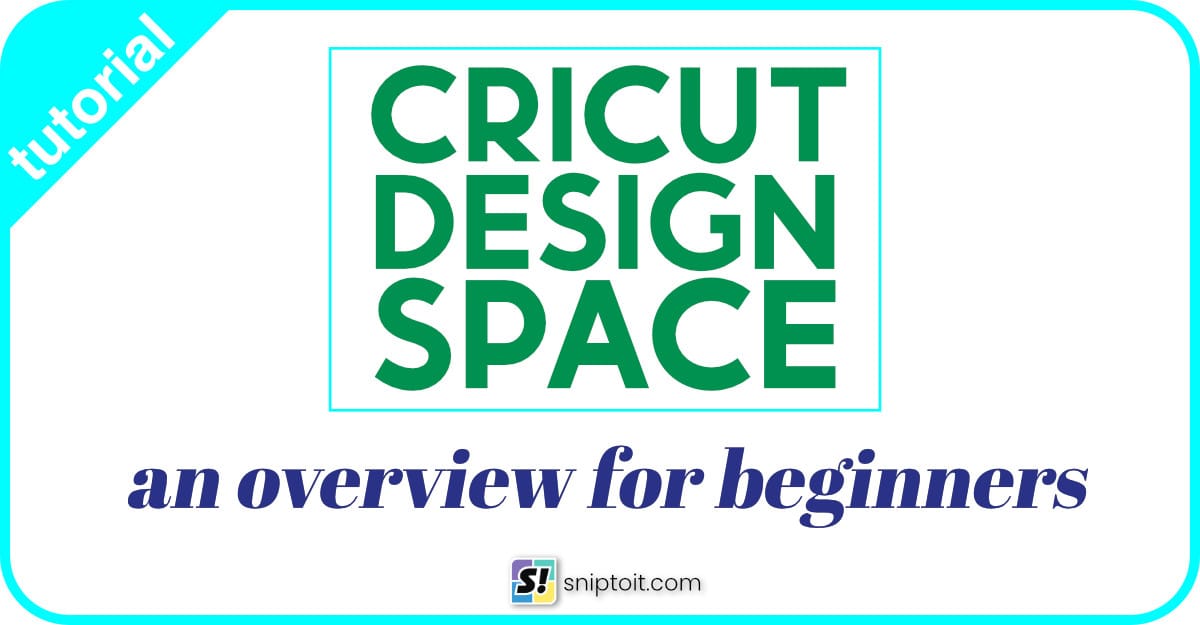Hi there new Cricut user! (And hello especially to the Cricut owners who have had their machines for awhile and have been afraid to unbox them). This guide is an overview of the current (January 2024) version of Cricut Design Space, guiding you through the software you will use to make all of your amazing Cricut creations!
This guide is for Design Space used with desktop or laptop computers (both Windows and Mac). If your screen doesn’t exactly match the screenshots you see in the guide, don’t worry – Design Space gets updated regularly and the look changes from time to time, but the core functions described here will be up to date.
You will need a compatible computer and an internet connection to use Design Space (Technically you can use Cricut software offline, but I have never had this work even one time).
If you’re still trying to get Design Space on your computer, this short article will explain the steps of downloading, installing and logging into Design Space. It just takes a few minutes and we can pick up where we left off.
What is Design Space and how does it work with a Cricut machine?
Like sending a document to your printer from MS Word, you will send projects from Design Space (DS) to your Cricut machine to be cut, drawn, foiled, engraved, etc. You can use DS to create or modify projects, but even if you want to use a cut file you got from Etsy, you will still have to bring that file into DS in order to send it to your machine to cut.
There are 4 main areas in Design Space:
- The Home screen where Cricut advertises featured projects, images, fonts, etc.
- the content on this screen changes frequently
- The Canvas, where you will actually design/import your project.
- The Mat Preview screen where you see the different parts of your project laid out as they will be cut
- The Set, Load & Go screen where you choose tools and settings before your machine actually begins drawing/cutting/foiling, or whatever else
The design is then cut piece by piece by your Cricut machine. Here’s the workflow:
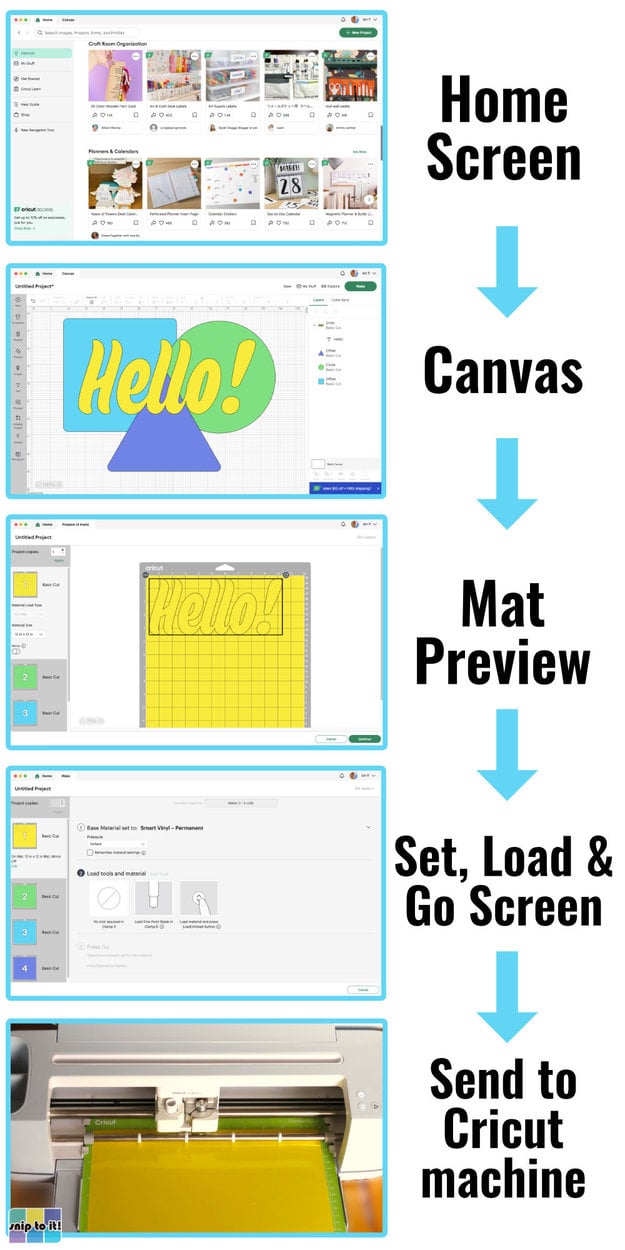
Step 1 – Home Screen vs Canvas
The home screen of Design Space looks a lot like a web page, showing you images, projects and fonts you might be interested in using or making. In the lefthand sidebar, there are links to Cricut’s online resources like Cricut Learn, the Heat Guide and the online store. These links open in your web browser, not the Design Space window.
Also in the sidebar is “My Stuff” which will show your projects-in-progress as well as bookmarked images and projects as you add them.
The home screen is different from the Canvas, where you actually design or import the project you want to make with your Cricut. Design Space will show you the home page first, and you must navigate to a blank canvas to start making.


Good to know – How to quit
If at any time you get annoyed, lost, stuck on a screen that just won’t close, or you’ve made some mistake and want to get out of your project so you can re-open it fresh: just get the heck outta there.
It doesn’t matter whether you are in the Home or Canvas tab, or anywhere else in Design Space:
In Windows: the X to close is at the top right-hand corner OR click the three dots next to the notification bell: File > Quit Cricut Design Space
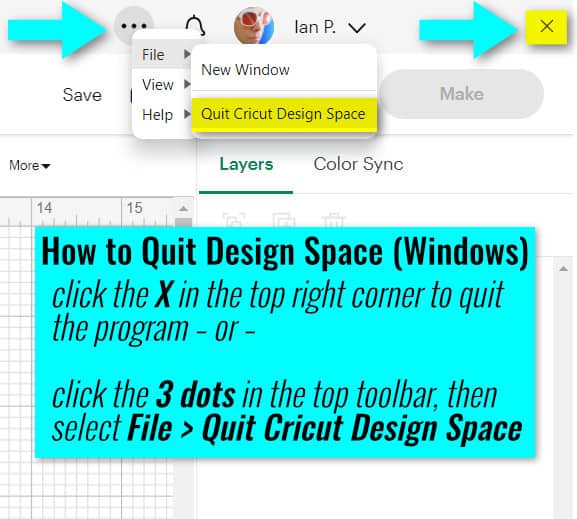
In MacOS: Click the red X icon in the top left corner of Design Space or press Command (⌘) + Q to quit the program.
If you have to quit Design Space because it’s not loading properly, running slowly or giving you a blank white screen, this troubleshooting article can get you back on track in just a couple of minutes.
Step 2 – Navigating the Canvas
There are 2 ways to open a new Canvas from the Home screen: click on the Canvas tab in the upper left hand corner, OR click the New Project button in the top right hand corner.
The Canvas is a workspace where you will create or import your project. You can add shapes, images and text and set them to cut, draw, print & cut, engrave, deboss, etc. with your Cricut. [NOTE: the Canvas will be blank when you open it. The screencaps of the Canvas shown in this guide have images and text on them to demonstrate various features]
Before we go any further, I want to point out where to find 3 important functions:
- How to undo
- How to save
- How to return to the main canvas window
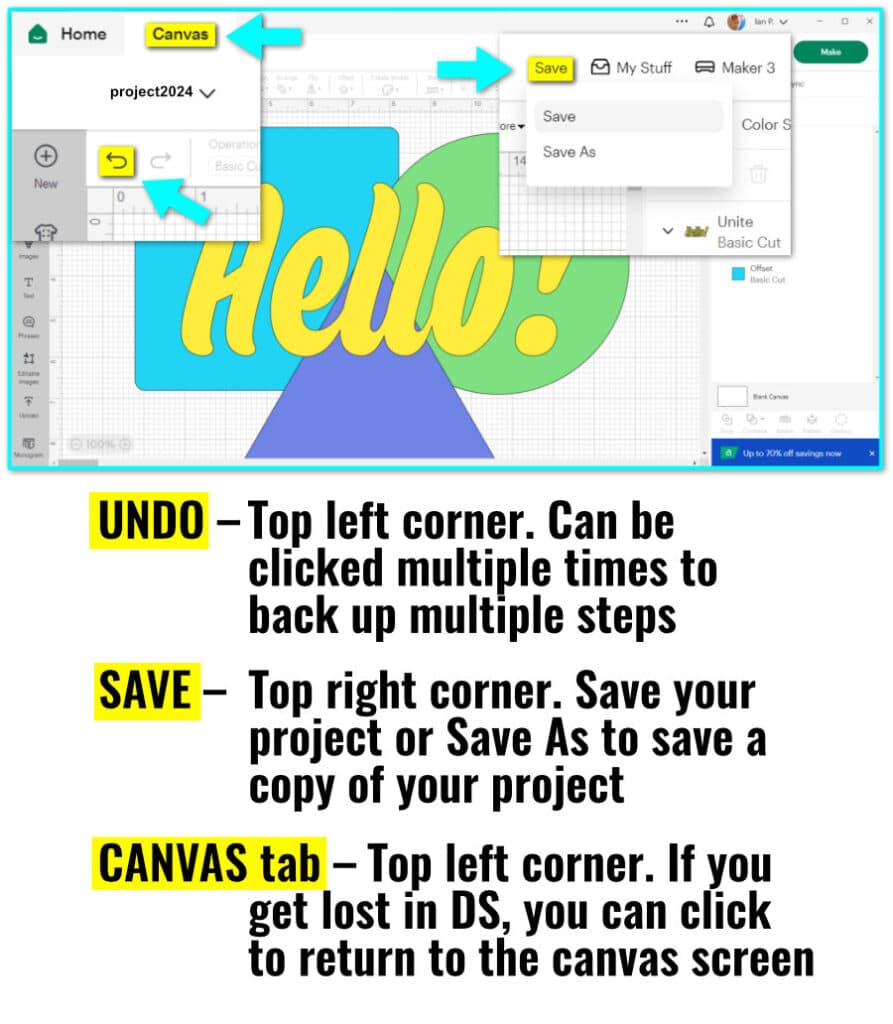
Basic Canvas features for beginners
The Canvas has 4 main areas:
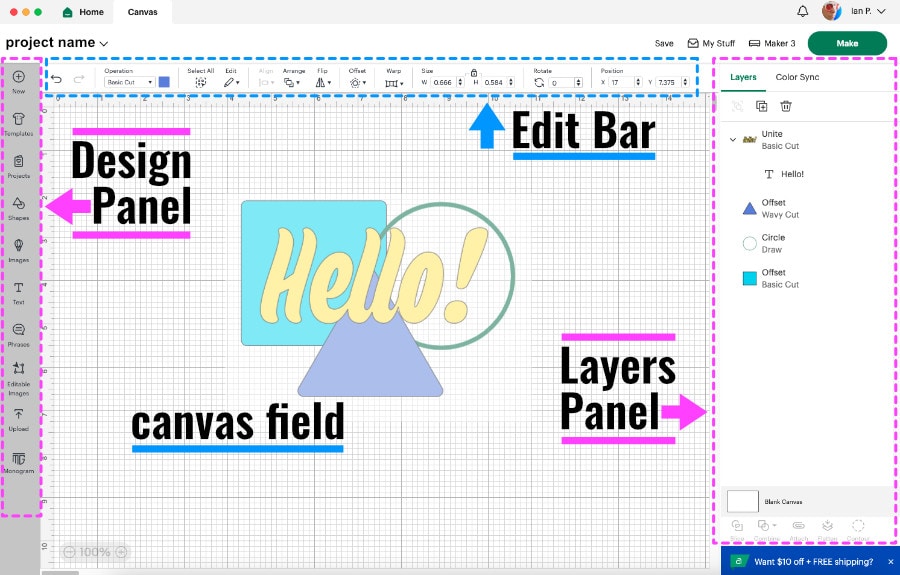
- the Design Panel (left hand side)
- the Edit Bar (top of screen)
- Layers panel (right hand side)
- the canvas field (the main area of the screen)
How the different panels work together
The easiest way to understand the basic layout of Design Space is to understand how the Design Panel, Edit Bar and Layers Panel work together to help you complete your design.
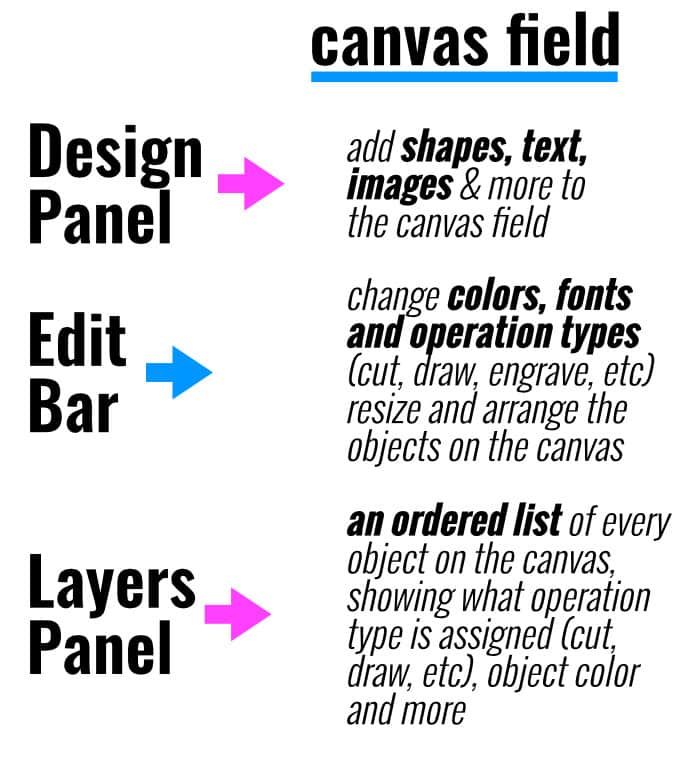
Think of it this way:
- Design panel: where you get the objects to make your design (shapes, images, text, etc.)
- Edit bar: where you make adjustments to all of those objects (change color, size, fonts etc.)
- Layers panel: a list and description of every object on the canvas (including information like color and operation type)
Design Panel Essentials
There are 9 items in the Design panel (from top to bottom):
- Templates (visual aids to help you picture and size your design) – I don’t find these helpful. Any design you make has to be sized correctly for the actual item you are decorating, and a lot of the templates are kind of weird. Go ahead, add the jeans template to the canvas and have a laugh!
- Projects (complete projects created by Cricut or Cricut Community members in a wide array of categories) – Pre-designed projects are super handy because all of the elements are already sized with their proper operation types pre-selected. A photo shows you what each project actually looks like IRL.
- Shapes (a menu of basic and specialized shapes) – More on this below
- Images (Cricut’s Image library has 600K+ images for your projects) – More on this below
- Text (add text boxes to the canvas) – More details follow
- Phrases (a subset of images that include ready-to-make phrases) – Over 3.9K versions of Live, Laugh, Love available – I’m not kidding!
- Editable Images (a combination of selected images with text you can customize)
- Upload (Where you can upload image files from your own computer in SVG, DXF, PNG, JPG, BMP, GIF or HEIC formats)
- Monogram Maker (combine images, text styles and frames to make a custom monogram) – Available to Access subscribers only
I am going to focus on only 3 key features here: Shapes, Images and Text. These 3 elements will be the foundation for many of the projects you will make – greeting cards, t-shirts, stickers and more!
Let’s make a simple thank you card that uses shapes, images and text to practice!
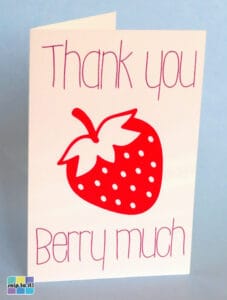
Adding Shapes to the canvas
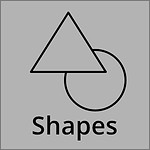
The Shapes menu is very straightforward: it is collection of shapes (ranging from basic to more complex) that you can add to the canvas.
For beginners, there are a couple of important points to keep in mind when you add shapes.
There are free shapes that are available to every Cricut user at the top of the menu. These are the basics, like square, circle, star, etc. These are the shapes you will use most, not just as a beginner, but at every skill level.
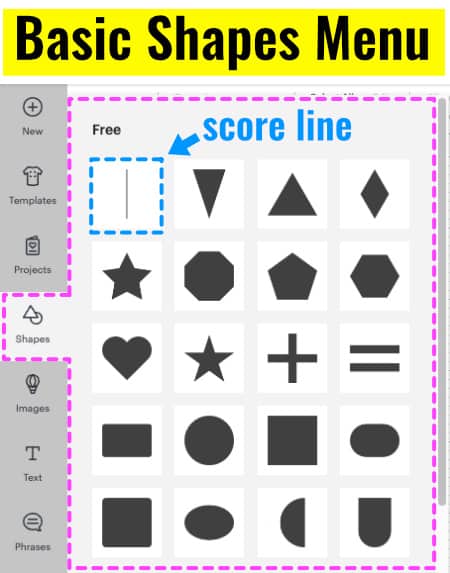
The more complex shapes at the bottom of the menu are reserved for Cricut Access members. These shapes include basic gift tag and label shapes, and other handy shapes that will make it easier to finish basic projects.
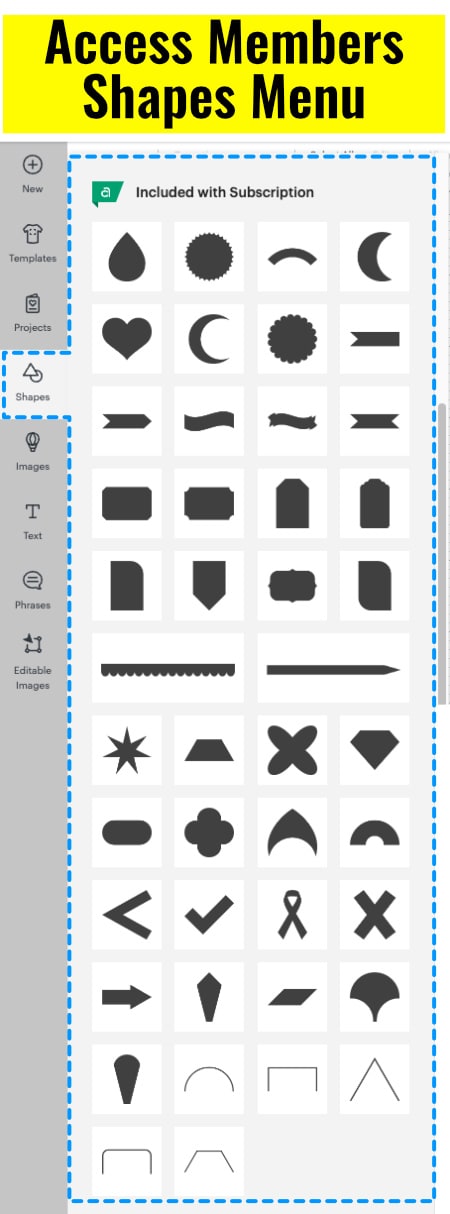
(Cricut Access is the paid monthly subscription service that offers an expanded library of shapes, images, fonts and projects to subscribers. Click here to read more about a Cricut Design Space account vs a Cricut Access subscription)
To add any shape to the canvas, just click on it in the menu. (No need to click and drag it to the canvas). The default color is charcoal grey, although you can update that in the Edit bar.
For our simple card, add a square and a score line to the canvas. We’ll turn the square into a rectangle for the card base, and we’ll score a line down the center with the Scoring Stylus to create a crease to fold the card in half. The score line looks like a perforated line, but it gets scored as a continuous line with the Scoring Stylus or Scoring Wheel, it doesn’t get cut.
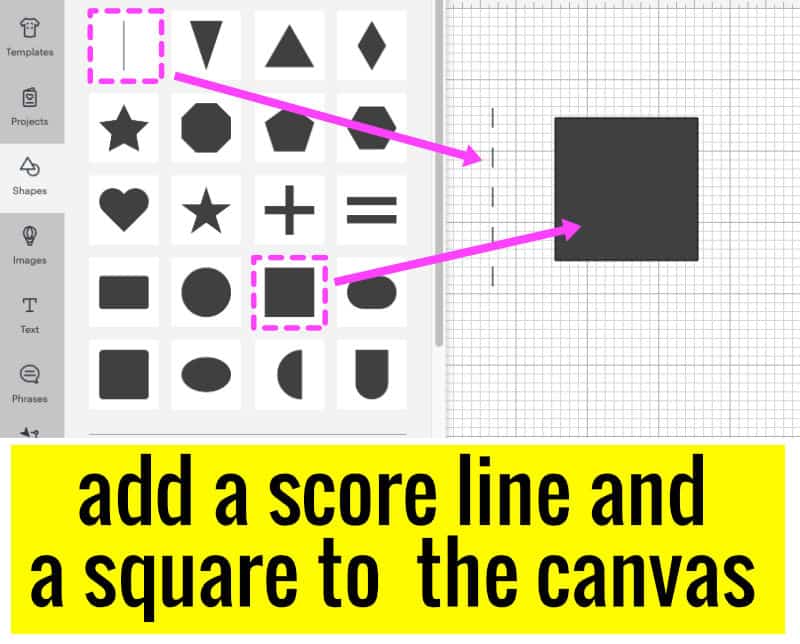
Adding Images to the Canvas
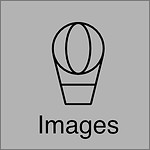
When you click the Images icon in the Design panel, it opens the image library, where you can browse over 600K images. Luckily, Cricut doesn’t just throw you in the deep end – you can browse by subject, graphic style, or theme, or you can search for something specific.
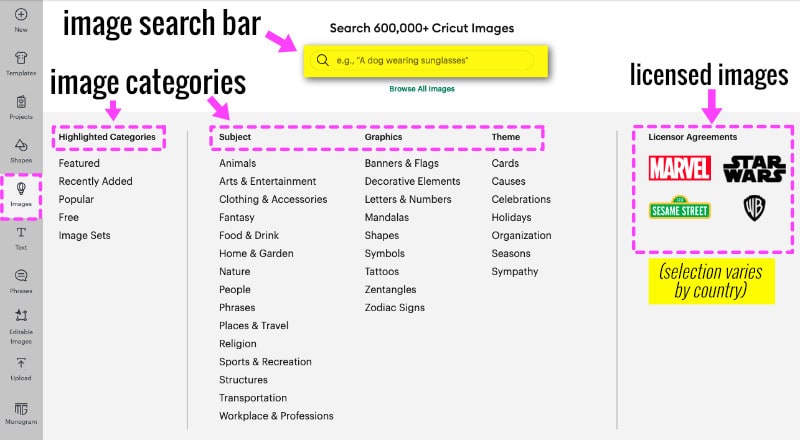
If you want to close the Image library and get back to the canvas, click the Image icon in the Design Panel on the left hand side of the screen. This is one area of DS where clicking the Canvas tab doesn’t return you to the canvas.
For my demo card, I’m going to search for a strawberry image. Type “strawberry” in the search bar and you’ll get a ton of results. There are filters on the left side of the screen that will let you filter by Operation type (cut, draw, print then cut, etc.), number of layers (single or multi) and so on. For this search I’m just going to click the “Free” filter at the top of the column. These images are available to anyone with or without Cricut Access.
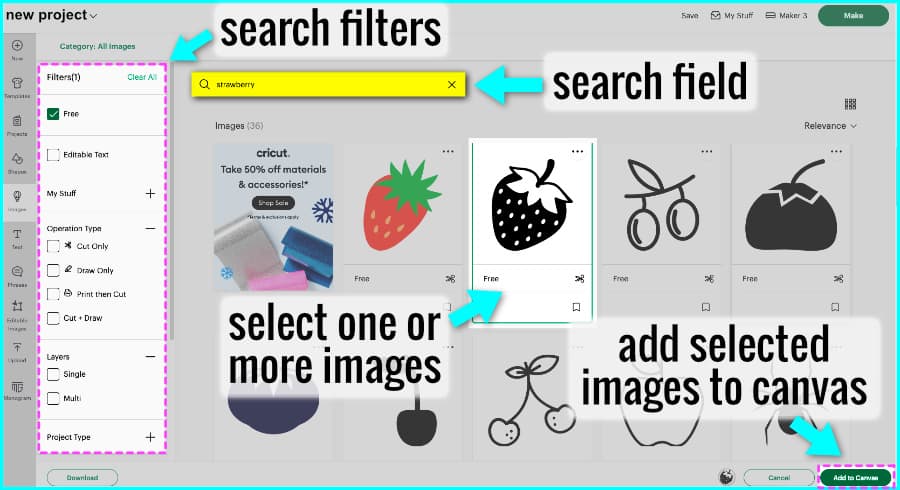
You can see that your choices get narrowed pretty quickly when you choose the free option, but nevertheless, I’m going to click an image to highlight it, and then click the Add to Canvas button at the bottom of the screen.
(You can also select multiple images and add them to the canvas in a batch in the Image Library.)
Adding text to the canvas
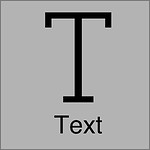
When you click the text tool icon in the Design panel, it adds a text box to the canvas. “Text” will appear in the default charcoal grey color, in the default font (Cricut Sans), with the default Operation type (Basic Cut).
All you have to do is type your text in the box and use the options in the Edit Bar to change the font, style, and color (more in the next section).
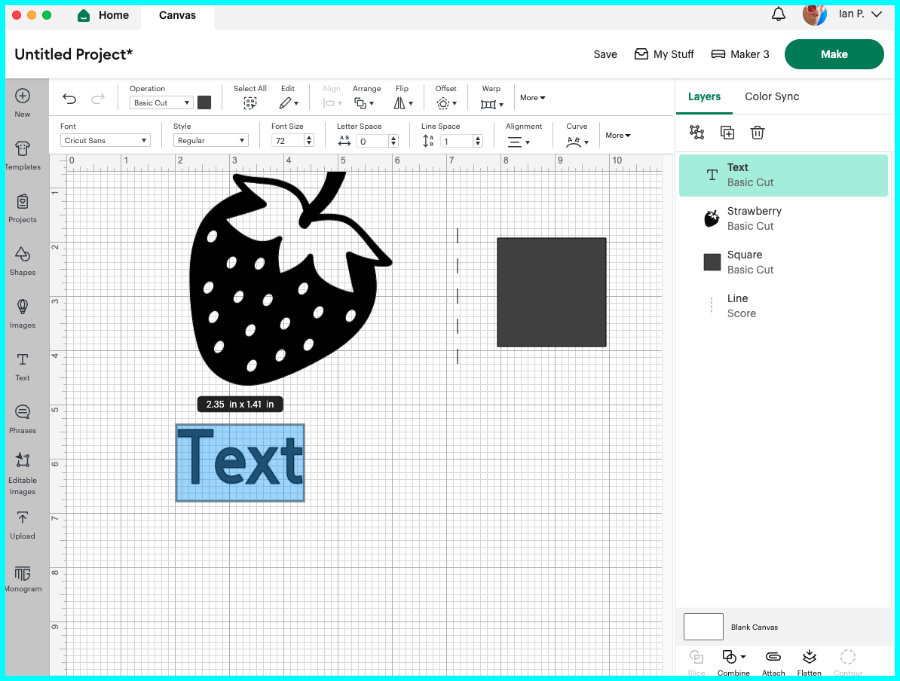
When you add a new text block to the canvas, it will be highlighted blue, meaning that you can just type your desired text on the keyboard and Design Space will fill in the text box. Whenever you want to edit text in a text box, double click it until the blue highlight appears, then you are ready to add new text.
For my practice project, I’ll type in “Thank You.”
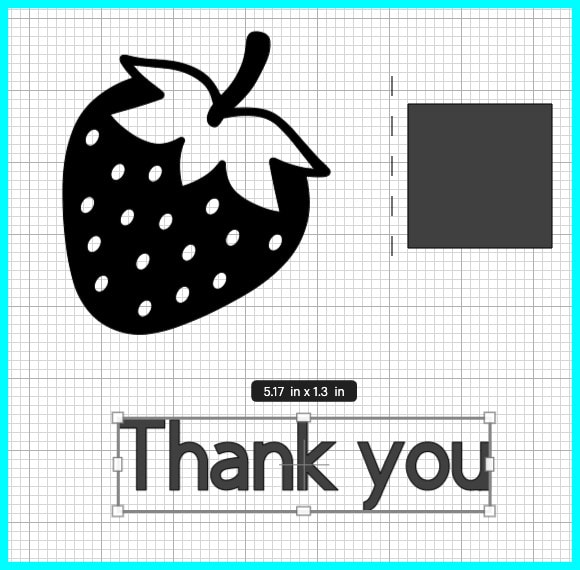
Using the Edit Bar with objects on the canvas
Here’s a quick overview of what’s in the edit bar and how each function and tool works with objects on the Canvas.
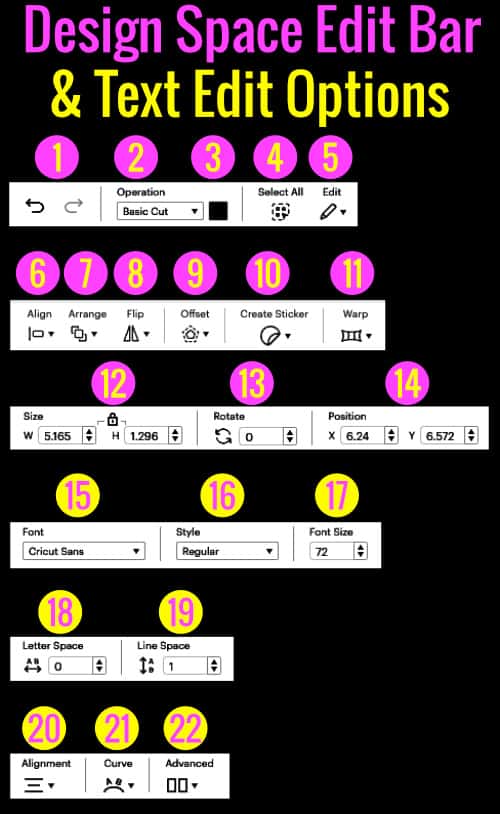
- Undo/Redo button: undo one or more previous actions
- Operation pulldown menu: a list of the cutting and drawing options that you can apply to an image, shape or text. The list of available operations depends on your Cricut machine. More details below.
- Color selector: a basic palette of color options you can apply to objects on the canvas
- Select All button: a quick way to select all of the objects on the canvas
- Edit pulldown menu: Cut/Copy/Paste/Duplicate/Delete functions
- Alignment pulldown: lets you align multiple selected objects at the top, bottom, center, etc. Will also evenly distribute multiple objects horizontally or vertically
- Arrange pulldown menu: lets you change the order of the objects in the Layers panel (moves objects to the front/back – more on this below)
- Flip Horizontal/Vertical: option to flip a selected object vertically or horizontally (creates mirror image)
- Offset tool: a specialized tool that will create a uniform layer behind the selected object, following the contours of that object. Very useful design tool that is discussed in greater detail in these articles:
- Create Sticker (NEW; for Cricut Access subscribers only): a specialized tool that automatically applies settings to create a sticker from an image. Will create die cut or kiss cut stickers, with or without an offset. This tool also preselects your cut settings for print-then cut materials.
- New to Print then Cut? Read our guide to calibrating your machine before you get started
- Text/image warp tool (for Cricut Access subscribers only): a specialized tool that lets you arch, warp or skew text and images. This article goes into greater depth about how the Design Space text warp tool works.
- Size adjustment: make precise adjustments to the height/width of selected objects on the canvas. When the padlock icon is closed, the original proportion is maintained. When the padlock is open, you can edit height or width independently.
- Rotate: rotate selected objects on the canvas up to 360 degrees
- Position: change an object’s position on the canvas by editing the X-axis (left to right) or Y axis (up or down)
Text Edit Bar (#15-22 in picture above):
When you have a text block selected on the canvas, a secondary edit bar will open and display the following options:
- Font selection menu: This pulldown menu shows you all of the fonts included with Design Space and also lets you select from fonts that you have installed on your computer. More details on this feature below.
- Font Style: This pulldown menu shows the available style options for any font you’ve selected (regular, bold, italic, writing)
- Font size: point size of each font (for crafters text box size is generally more important than point size)
- Letter spacing: Highlight a block of text and you can adjust the spacing between letters
- Line Space: Highlight multiple lines of text inside the same text block and you can adjust the distance between lines of text
- Alignment: select left, center or right justified text
- Curve: different from the Text Warp tool, this feature will align text to the edge of an circular curve without distorting the shape of the actual letter.
- Advanced: options under this pulldown allow you to ungroup text blocks so individual letters, lines or layers of text will be treated as separate objects by Design Space
How to resize shapes
Resizing objects on the canvas is a basic function you’ll use for most projects. You can do this a couple of ways with your cursor:
- Select the object and drag one of the corners in or out. This will resize the object while maintaining its original proportion
- Select the object and hover your cursor over an edge until the cursor shows you a double headed arrow (↕︎) or (↔︎). Click the edge and drag it in or out to resize the object height without changing the width (or vice versa).
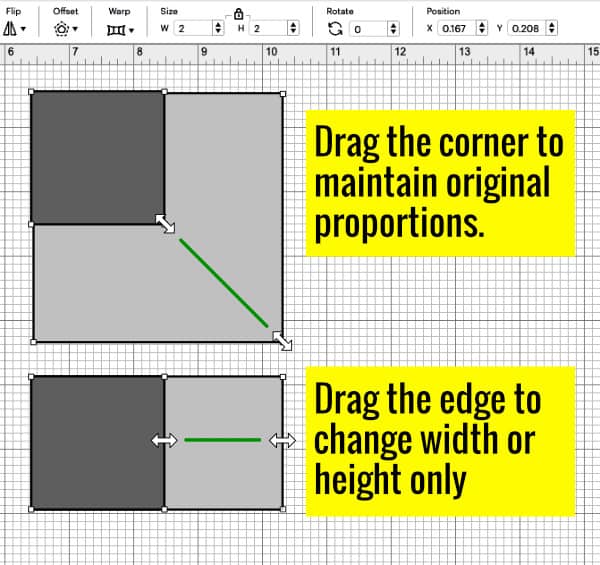
You can also choose exact measurements using the size adjustments on the Edit Bar. Select the object and enter the width and height you want in the size adjustment field in the Edit Bar. You can change the proportions by clicking the padlock icon to unlock it. Otherwise, the padlock will ensure that the original proportions will always be maintained.
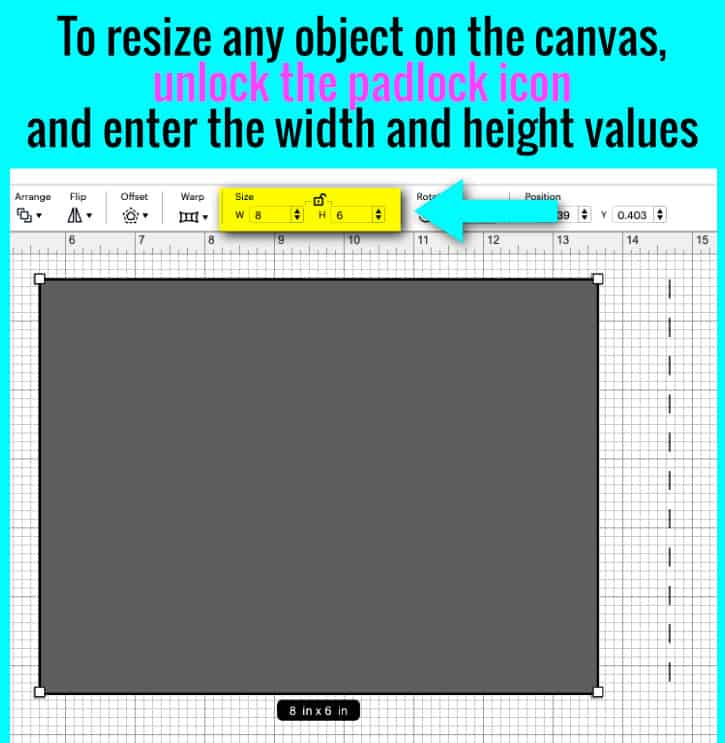
For the practice project, select the square on the canvas, and unlock the padlock icon in the Edit Bar. Enter a width of 8 inches and a height of 6 inches. After the square is resized, click the padlock closed again. Next select the score line and change the height to 6 inches as well. This will end up being a 4×6″ card with a score line down the middle.
How to change the color of an object or image
To change color, select an object on the canvas, and click the small square next to the Operation pulldown. You’ll get a basic color palette to choose from and you can select any color. You can also choose the advanced option to enter a precise hex color value if you want.
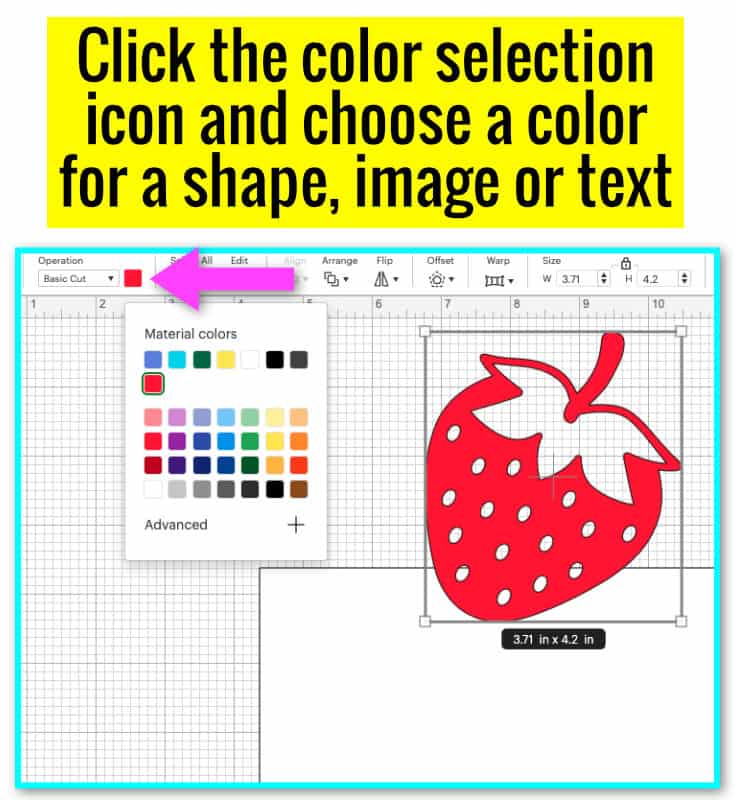
For the project, I select the strawberry, then click the color selector icon in the Edit Bar, and change the color to red. Select the rectangle shape and change the color to white.
Design Space uses colors to keep different objects organized. Once you send your project to be cut by the machine, Design Space will group objects of the same color on the same mat in the Mat preview screen.
How to change fonts
To change fonts in Design Space, select a text block on the canvas and then open the font menu in the Text Edit Bar. Inside the font menu, you’ll see a number of options:
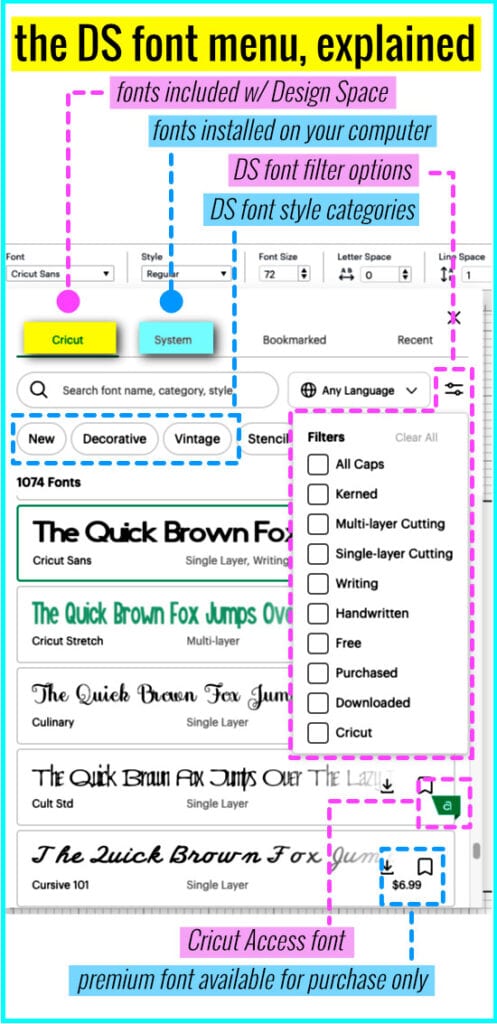
Cricut fonts are included with Design Space. Some are free and available to all users, but most are for Cricut Access subscribers (indicated by a green banner). Non-subscribers will be asked to pay for Access fonts before making their project.
System fonts are fonts that are installed on your computer. These can be the classics included by Windows or Mac (like Times New Roman or Arial) or these can be fonts that you download from third party sites like Dafont or FontSpace.
Cricut fonts can be searched or browsed by categories like Retro, Modern, Farmhouse, Christmas etc., and you can use filter options to choose more specific categories (All Caps, Single or Multi Layer, or Writing fonts). Filtering by Free will show you the fonts available to non-subscribers. You can also bookmark favorite fonts.
For the practice project I will be writing the font on the card, so I select the text block, open the font selection menu, open the filter options and tick the “Writing” and “Free” boxes. I’ve selected Little White Lies from the list, but you can choose whatever font you like.

How to change font style from regular to writing
Select your text and go to the Style pulldown menu and choose Writing:
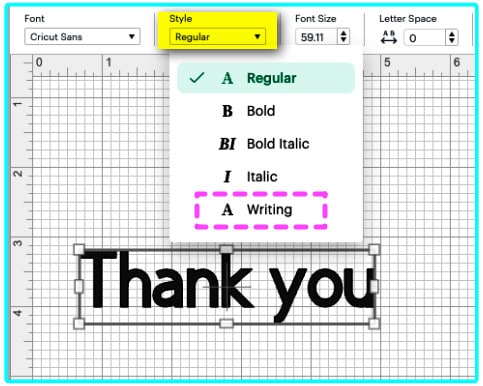
Both Cricut and System fonts can have Style options that include Regular, Bold, Italic, or Bold Italic (e.g., both Cricut Sans and Times New Roman have all those Styles available). Many (470+) Cricut fonts also have Writing as a style option.
Many Cricut fonts that have a writing style will write as single line fonts, but “Writing” does not always mean “single line”. A very large number of Cricut writing fonts are open/outlined/bubble fonts. If you select “Writing” style for a font, the Operation type will automatically be set to Draw (more on this below).
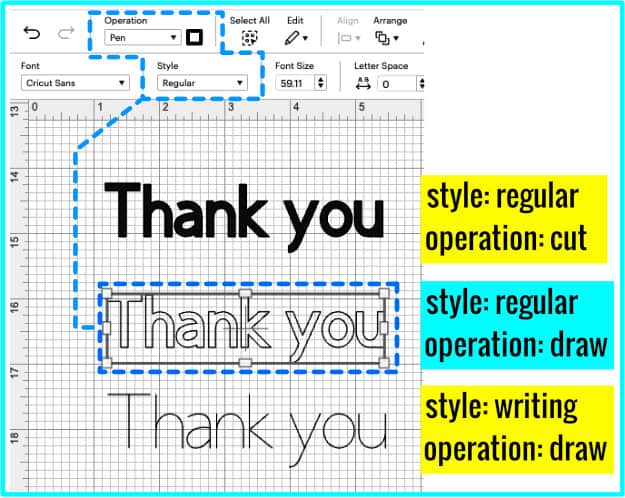
How to change operations
In DS, “operation type” refers to what kind of tool will be used to execute the tracing of the shape, image or text. The basic operations are cutting, drawing and scoring, but Cricut machines are capable of doing more for complex projects.
Each type of machine (Maker, Explore and Joy) has a preset selection of available tools and operations. When you have DS open, your machine type will be selected in the top right corner, next to your profile photo. Your available operations are determined by the machine you are using.
Here’s a list of all the operations each type of Cricut machine can do:
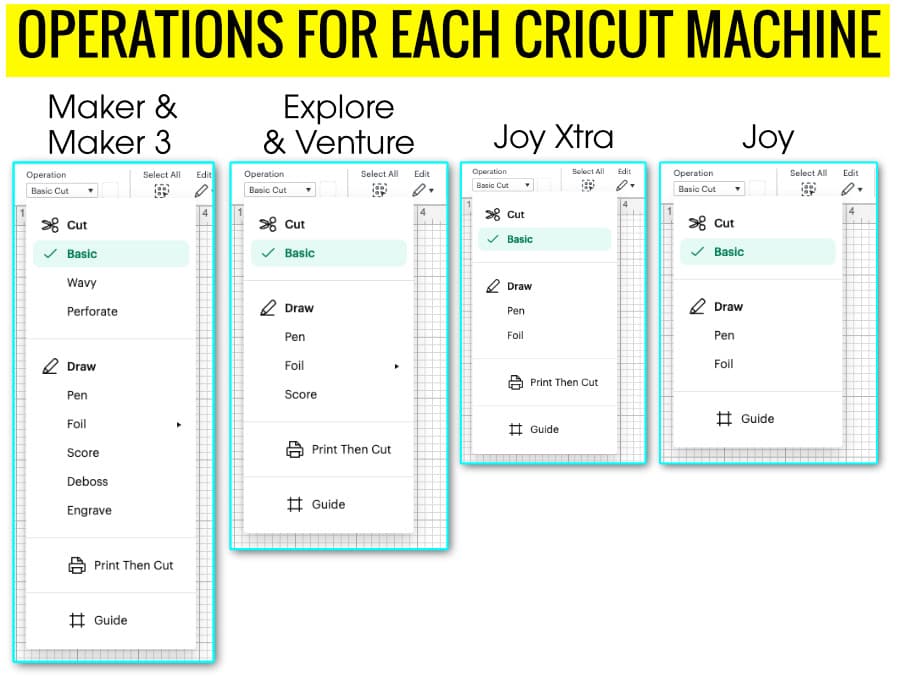
For our example project, select the text block and open the operation menu, and change the operation to Draw > Pen. In most cases, you’ll see the text change from a solid color to an outline.
Next, select “Writing” from the Style pulldown menu.
From here, you can click the color selector and choose your pen thickness and color, and the text block will change to reflect the weight of the pen and the color of the ink. The colors, ink types, and pen thickness are based entirely on Cricut brand pens, with 0.4mm black Fine Point as the default.
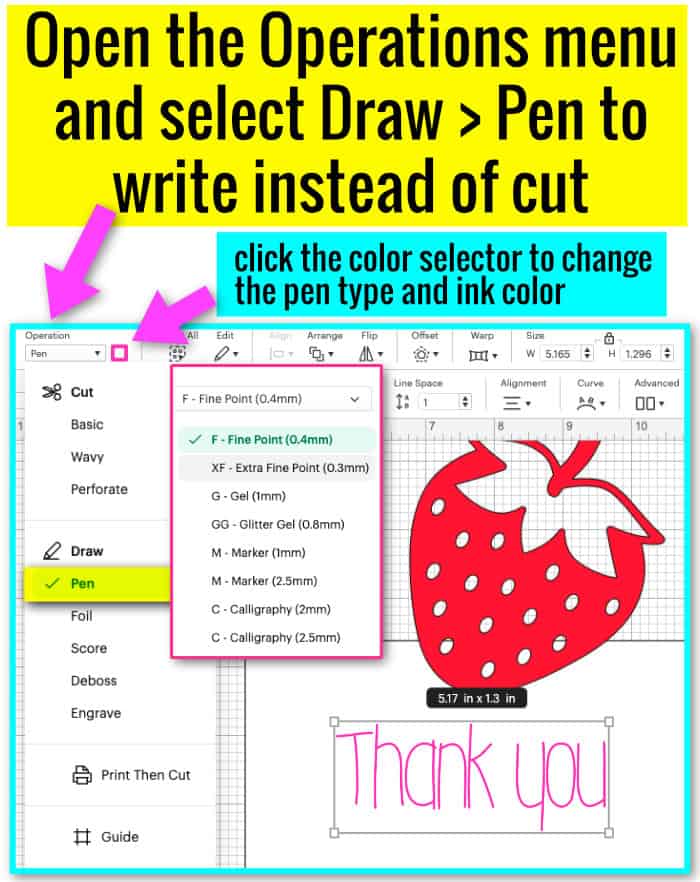
Understanding the Layers panel
The Layers Panel helps keep everything organized in Design Space. It reflects the order in which all of the objects on the canvas are stacked from front to back.
There is a selection of tools in the Layers panel that help keep objects and text organized for an easier experience in DS. Here’s a brief overview of what everything does:
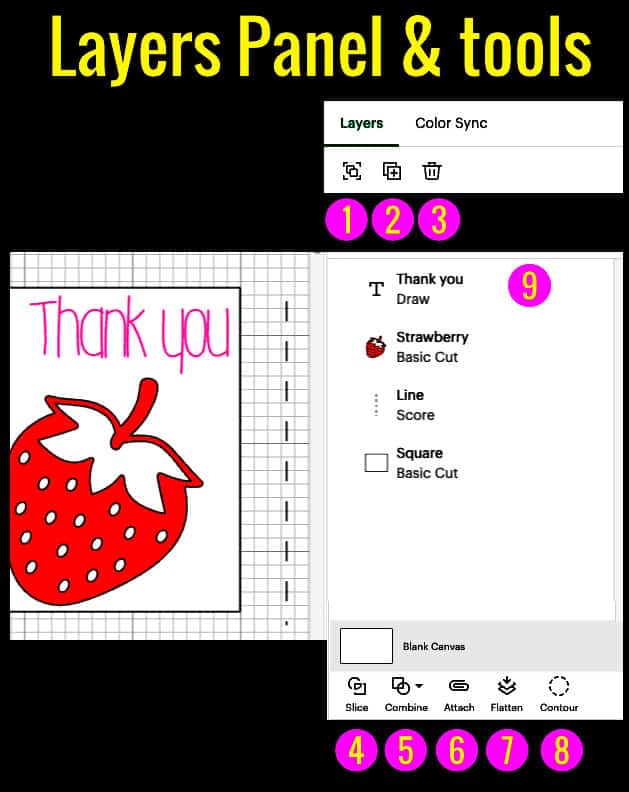
- Group: select 2 or more objects and use group to keep them together on the canvas (they will NOT be grouped on the mat)
- Duplicate: select an object or text and click Duplicate to create a copy with the same color and operation type
- Trash: delete one or more objects from the canvas
- Slice: select 2 overlapping objects, and the Slice tool will cut the top shape out of the bottom shape
- Combine: a suite of tools that allows you to add, subtract, intersect and exclude multiple overlapping shapes. For a deeper dive into how to use the Combine tool, read this article:
- Attach: works like the Group function to keep multiple objects fixed in relation to one another, both on the canvas and when you make your project. Required to keep different operation types like draw and cut together. More on this below.
- Flatten: select multiple objects and flatten into a single layer for Print Then Cut projects
- Contour: selectively remove cut lines or draw lines within an object. Often used to simplify graphics or to make simple graphics multi color. For more information on how the Contour tool works try reading this article:
- Contents of the layers panel: a list of all of the objects on the canvas, with a notation of their design element (eg shape, text, image), operation type (cut, draw, score) and the order that they are layered on the canvas, front to back
How to change the layer order
If you need to change the layer order in DS – if you need to send a large object to the back because it’s blocking your view of another object for example – there are 4 easy ways to get it done:
- Select the object you want to move. Click the Arrange icon in the Edit bar and select from Bring to Front, Move Forward (1 layer up), Send Backward (1 layer down), and Send to Back (move object to bottom of the layers list). OR
- Select the object and right click your mouse and choose from the same options in the popup menu. OR
- Use keyboard shortcuts
- Windows: Bring to Front – (shift) + (CTRL) + ( ] )
- Bring Forward – (CTRL) + ( ] )
- Send Backward – (CTRL) + ( [ )
- Send to Back – (shift) + (CTRL) + ( [ )
- Mac: Bring to Front – (shift) + (⌘) + ( ] )
- Bring Forward – (⌘) + ( ] )
- Send Backward – (⌘) + ( [ )
- Send to Back – (shift) + (⌘) + ( [ )
- Windows: Bring to Front – (shift) + (CTRL) + ( ] )
OR: 4. You can also click and drag a layer up or down in the layers menu.
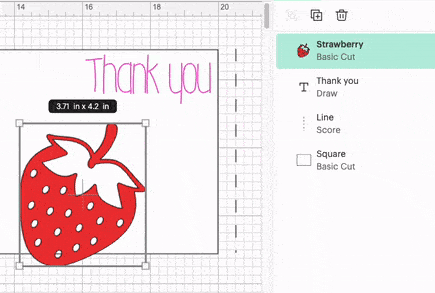
How to duplicate an object
Duplicating an object is very straightforward. You can select one or more objects and click the duplicate icon in the layers menu. The copy of the original will have the same colors and operation assigned to it.
You can also duplicate by:
- press ALT + click on the object with your mouse (Windows) or Option + click (Mac) – this creates a duplicate directly on top of the original
- open the Edit icon in the Edit Toolbar and select the Duplicate option OR
- right click on the object and select Duplicate from the pop up menu OR
- select the object and use the keyboard shortcut (CTRL) + D (windows) or (⌘) + D (Mac)
For our practice project, select the “Thank you” text box and duplicate it. Click the second text box to highlight the text, and type “Berry much”. It will still be the same font, same pen type and same color.
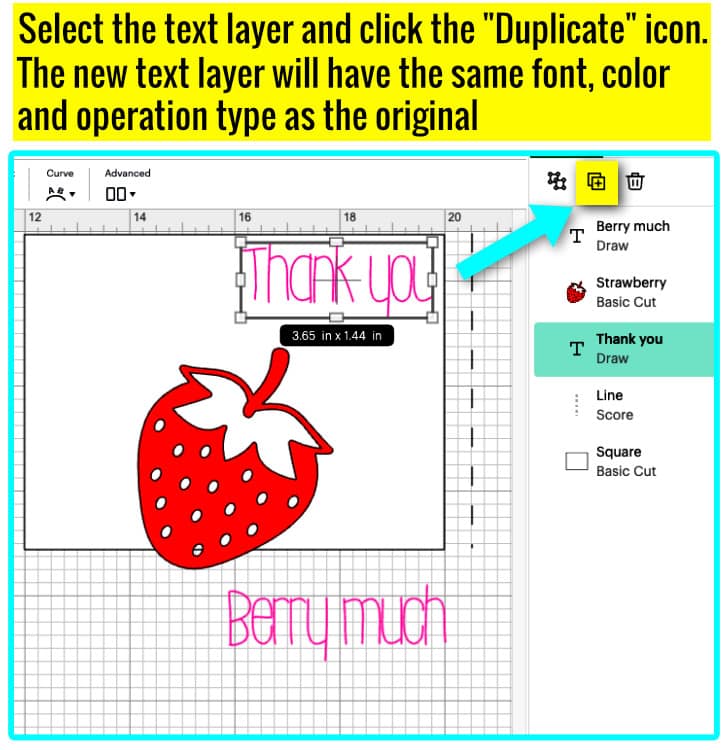
How to Attach objects with different operations
Our practice project now has a base rectangle, written text, an image and a score line. To put the operations together so your Cricut machine can score and draw on a piece of cardstock, and then cut it out:
First, select the score line and the rectangle shape. Open the Align menu in the Edit Bar and select “Center” at the bottom of the list. This will center the score line both horizontally and vertically with the rectangle.
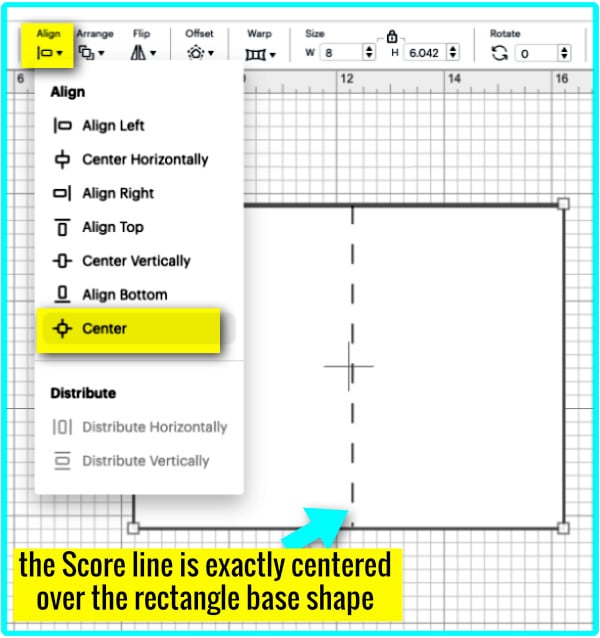
Now, with both the score line and rectangle selected, click the Attach icon at the bottom of the Layers menu. Now both objects will be treated as a single entity on the canvas, and they will be attached together when you click the Make button and go to the Mat preview.
But we’re not done. After you Attach any objects, they go to the top of the layers panel by default. Select the rectangle and use Arrange in the Edit bar to Send to Back.
Next, select the text blocks, resize and arrange them on the right side of the base (front of the card). When the text fits, select both text blocks and the rectangle/score line. Click the Attach icon again and attach all 4 of these elements. This means that when you send this project to your Cricut machine, it will know to make a score line, write the text and cut the rectangle on the same piece of cardstock.
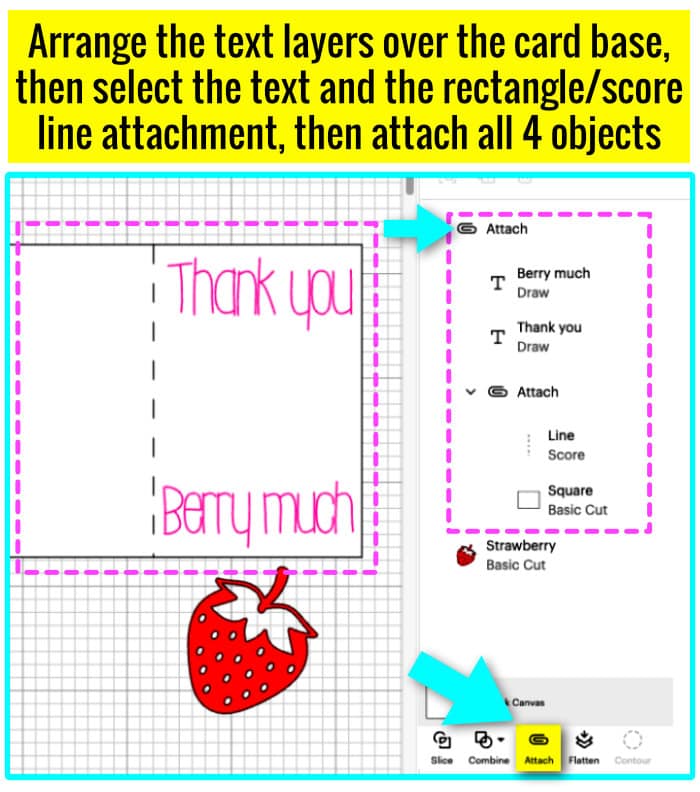
Finally, resize your strawberry so it fits between the text blocks. It will be cut out of a separate piece of material than the card base, so we don’t have to worry about attaching it to the other pieces.
The Make Button and Mat Preview
Now that the practice design is finished, click the Save button in the top right corner, and then click the Make button to go to the Mat Preview!
[the screen dims, a circle spins, the tension builds]
If you have a Maker machine, you’ll get a popup window open asking you what kind of mat you’re using. I am choosing to use a regular mat. (Even though we are making a card, the card mat is intended for a different type of project)
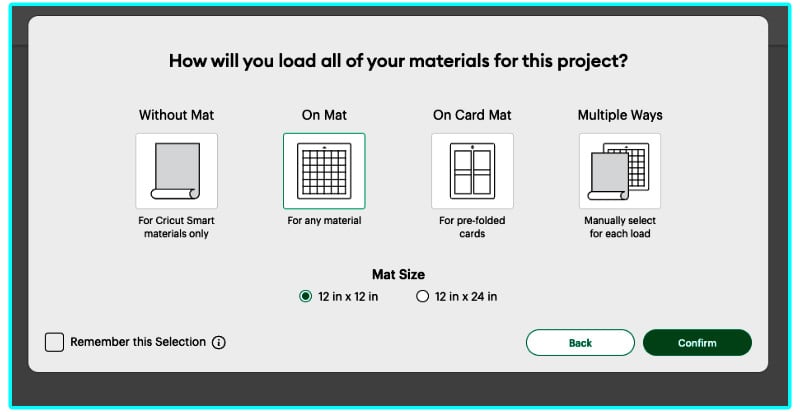
After you make this initial selection, the Mat preview window will open. Here’s a quick explanation of the information on this screen
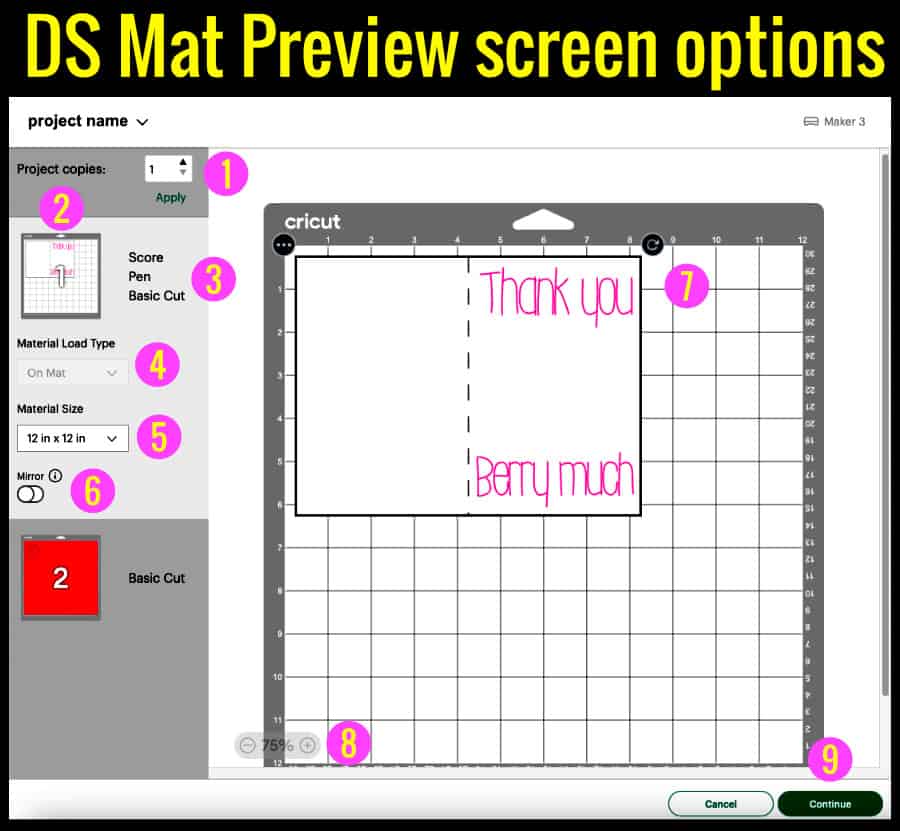
- Project copies: a quick way to make multiples of every element of your project. A good shortcut if you want to make more than one copy of the same card, t-shirt decal, etc.
- Mat order: running down the left side of the screen is a color coded series of mats, representing the colors you have used in your project. More on this below…
- Order of operation: The operations being performed on that mat, in order (top to bottom)
- Material load type: a pulldown showing the type of mat you will be using for that operation (On Mat, Without Mat, Card Mat) – if you already chose this in the previous step, this will be greyed out
- Material size: pre-selecting a material size will generate a preview of the object on the mat with that material size. Sizes are standard (e.g. 12×12″, 8.5×11″, etc.) and include over a dozen options for cutting with a mat; matless cutting allows you to enter a value for length. Don’t worry about it, it’s optional
- Mirror setting: flips everything on the mat horizontally. Essential if you are cutting iron on material/HTV
- Mat Preview: a preview of where the image will cut on the mat so you can make sure it will line up with your material. You can drag an image anywhere on the mat, rotate it, or hide it. More on this below...
- Zoom in/Zoom out: zoom in to get a closer look at your mat
- Continue button: after you are finished with your preview, click Continue to proceed to the Set, Load and Go screen
Operations order for every mat
The order of operations for every mat is right next to the little thumbnail preview in the left sidebar. It shows you what operations are happening and in what order.
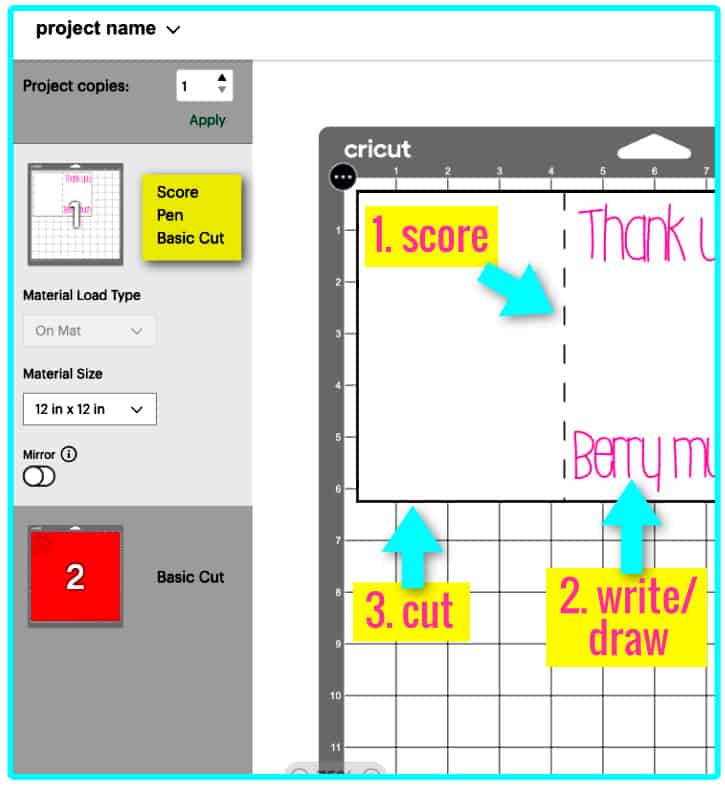
For our project, on mat 1, the Cricut machine will score first, then draw/write, and finally cut. Generally Design Space does scoring operations first, then pen operations, then other operations like foiling or debossing, and then cutting last.
Sometimes people ask if you can change this order, but the answer is there is no straightforward way to do this. If you have some practice, you can figure out workarounds for different projects, but that’s information for a more advanced tutorial.
Rearranging objects on a mat
One more thing to note about the mat preview: Design Space will place objects on the mat starting in the top left corner. You can select an object on the mat and move it to a different location. You can also rotate an object. Why is this important? You can do this to save material, or get a better fit on an odd sized piece of material.
If you select an object on a mat, you’ll also see an menu option with 3 dots in the corner. Click the dots and you’ll get two more options: Move Object and Hide Selected.
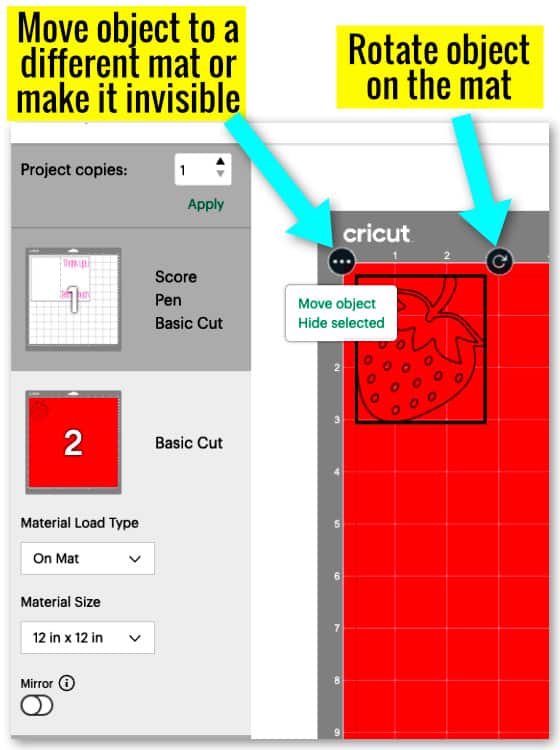
Move Object means that you can move that object to a new or different mat. Why would you need to do this? Say you are working on a project where you are cutting a red shape out of cardstock and red text out of vinyl. DS sees them as the same since they are both red. But you can select one and move it to another mat for a separate cut. You can also move a bunch of objects to the same mat to save time.
Hide Selected means you can make an object on the mat invisible. This is another good way to skip an operation if you want to, then come back to it later.
Mat order and how to change it the easy way, no planning needed!
Design Space will order your mats according to object color: print then cut first, then white > gray > black, then colors, following ROYGBIV of the rainbow.
This is just the default SUGGESTED cutting order, however. It is a common misconception that you must cut your mats in the order Design Space tells you. You can cut your mats in any order you like. If you click the mat thumbnail in the sidebar and the area around it turns white, that mat is the active mat and will be the next one in the queue for the machine.
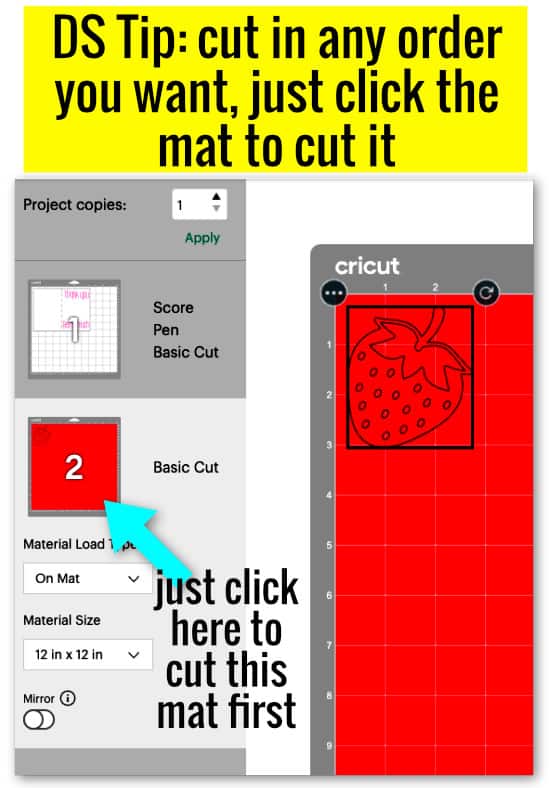
And here’s another tip: After you have cut a mat, DS will display a checkmark over the thumbnail to indicate it is complete. You can still select that mat and make the same cut over and over again without quitting the task.
Navigating the Set Load and Go screen
After you have arranged your objects on your mats in the Preview Screen, you get sent to the Set, Load and Go screen. This is where you select your materials so the Cricut machine knows what settings to use. Design Space will also let you know which tools you need, but you can also change that too!
Note: Design Space will only show you the selection options on this screen if your Cricut machine is powered on and connected to your computer.
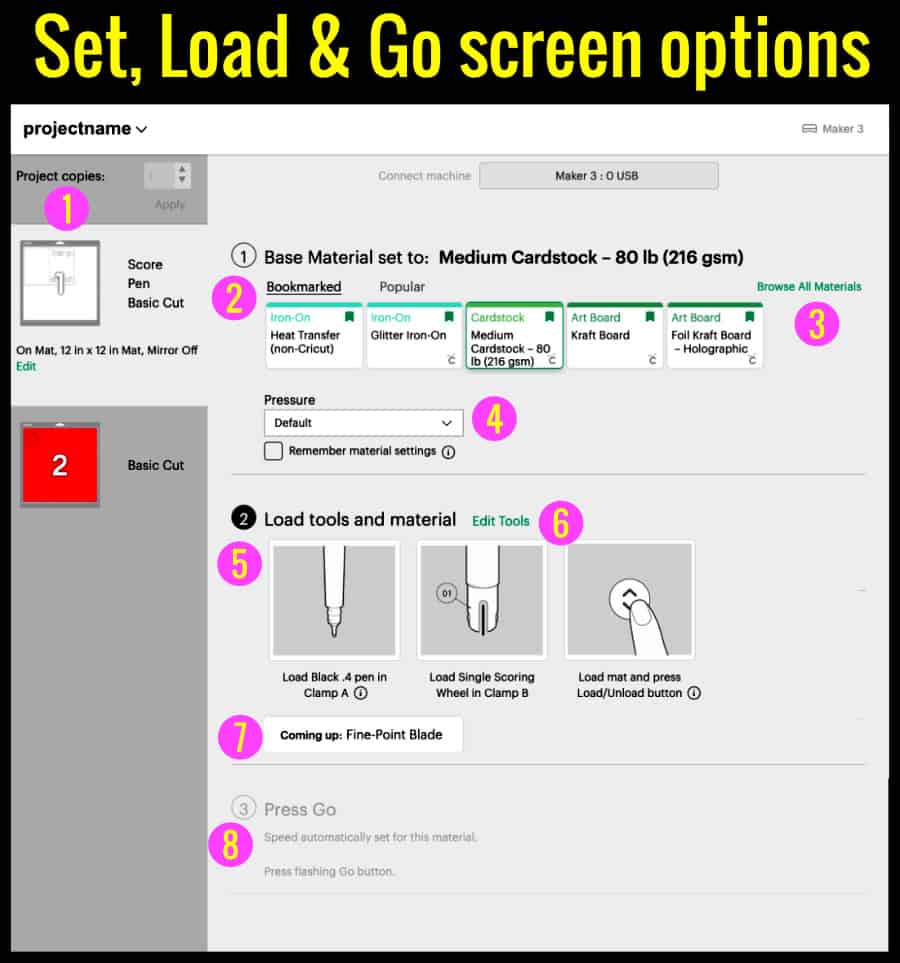
- Mat preview/mat order: Shows the active mat to be cut, plus the other mats in the project. Gives information on the mat selection, material size and mirror status. Also lets you edit the position of the objects on the mat before you send the mat to the machine
- Material selection list: A list of your bookmarked and most popular material settings for you to choose from. You can select the material you want to cut from this list to proceed
- Browse all materials: a full list of materials that you can choose from, as well as the option to create a new custom material setting
- Tool pressure menu: a pull down menu that lets you select cut pressure instructions for the machine (more, less, or default)
- Tool and mat load instructions: based on the order of operations, Design Space will tell you what tools to load in your Cricut machine in tool carriage A and B. DS also prompts you to load your mat into the machine and press the Load button (↕︎)
- Edit tools option: in certain situations, you can select an alternate tool for the operation. More on this below
- Tool change prompt: if you have multiple operations, Design Space will tell you what tool is coming next
- Press Go prompt: after your materials and tools are selected and you have loaded the mat, DS will prompt you to press the Go button (▷) to start the operation
How to select materials on the Set, Load and Go screen
After you exit the Mat Preview, Design Space will take you to the Set, Load and Go screen and prompt you to select the base material you will be cutting/drawing on. The most common categories are cardstock, vinyl and iron-on material, but within those broad selections are variations that the Cricut machine will cut with different amounts of pressure.
DS will show you your bookmarked materials first. If you are brand new to Cricut, you might not have anything on that list. You can click the popular materials selection, or you can browse the full list of materials.
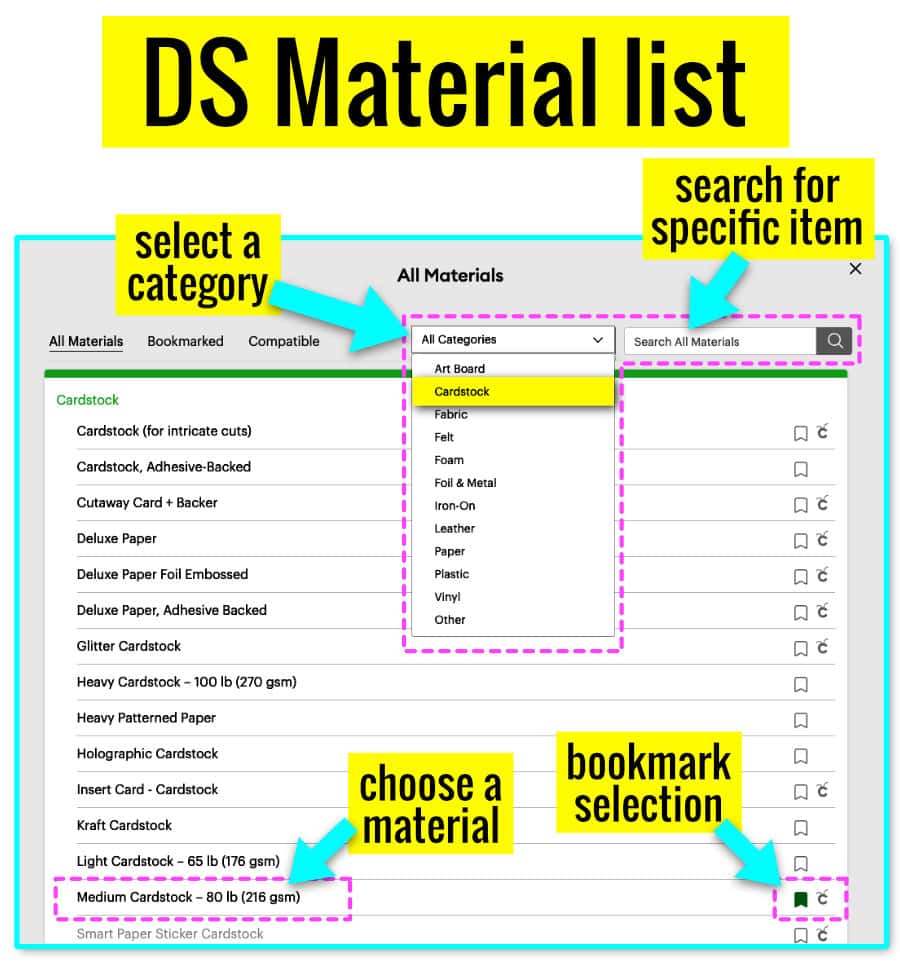
When you select “Browse all materials,” you’ll see a full list of materials compatible with your machine. You can open the category menu at the top of the list and then make a selection from the specific materials in that category. You can also add materials to your bookmark list.
For our project, the white base is going to be cut out of cardstock. I usually use cardstock labelled as 65 or 80lb cardstock. (Cricut cardstock is 80lb.) I find that using the Medium Cardstock cut setting works best for this material. Select it from the list.
TIP: cut settings will be something you often have to mess around with depending on the material you’re using. If you want to get some insight into the differences in cutting pressure and tools used for different materials, I highly recommend checking out Cricut’s giant list of materials and cut settings for each machine.
Tool selection and prompts
After you have selected your material, Design Space will prompt which tools to load first. If you have a Maker, Explore or Venture machine, there will be two thumbnail images showing what tool goes in the left and right clamp (aka clamp A & B). (Joy and Joy Xtra users will see a single preview image.)
There is also an option to edit the default tool selection. Case in point: if you have a Maker machine to make our practice project, DS will prompt you to load the pen in clamp A and the Scoring Wheel in clamp B. I’m going to use the Scoring Stylus instead. So, click the Edit Tools option, and select the Scoring Stylus option.
Now, the Set load and Go screen prompt tells me to load the Scoring Stylus in clamp A and the Fine Point Blade in clamp B. The pen is listed as coming up next.
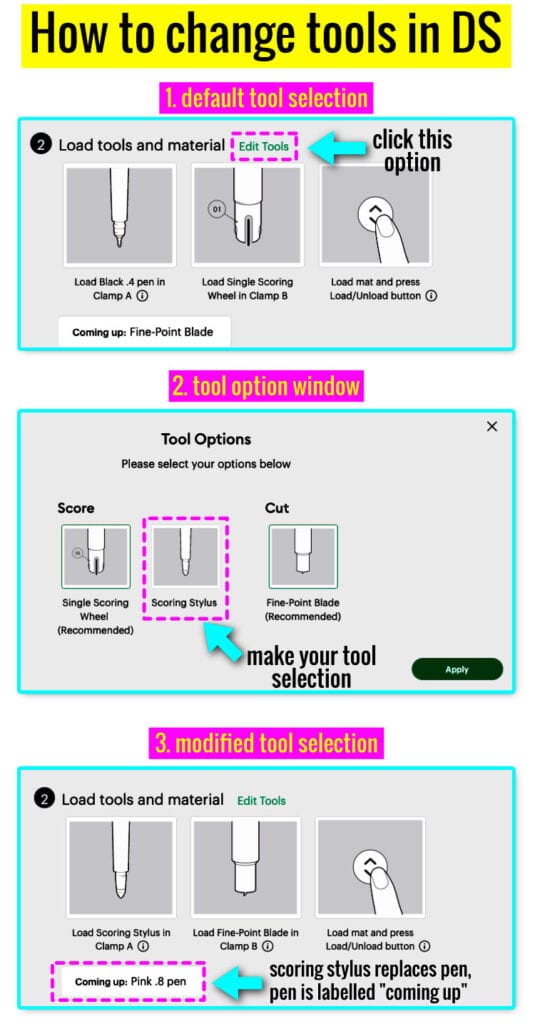
We’re finally cutting!
Now that the materials and tools are selected, we can finally make our project in real life! First step, put your material on the mat. I’m using white cardstock as the base of this card, so I’ve lined a sheet up in the top left corner of the mat to match the preview.
Loading materials on mats is another tutorial, but I will say that I always use a brayer to firmly stick my cardstock to the mat without any bubbles underneath. If you’re really unfamiliar with using machine mats, remember to remove the plastic cover from your mat before using. Replace the cover after you’re done to keep the mat clean.
How to load a mat in a Cricut Maker or Explore machine
After you have made the material and tools selection in Design Space, the load button on the machine will start flashing. Lay your mat underneath the guard tabs and gently push it into the grey roller wheels. When you feel like the full top edge of the mat is pressed against rollers, press the Load button. The machine will pull the mat under the rollers and then you will be ready to start cutting. Press the Go button when it starts flashing!
You need to leave enough space around your machine so the mat can move in and out from front to back. The Maker 3 measures the material to start with, so it will move the mat all the way back and forth before beginning the operation.
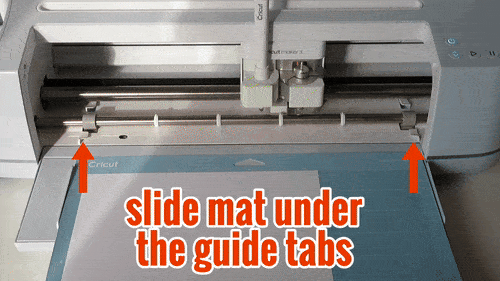
Loading and changing tools in the Cricut machine
It’s important to follow the tool prompts from Design Space. DS will tell you what tools to load first, then it will pause the machine to allow you to change the tool. For example, in our practice project, I have to load the Scoring Stylus in clamp A to begin the operation, then the machine will pause and tell me to replace the scoring stylus with the pen. After I have made the replacement, I must push the GO button on the machine to resume operation.
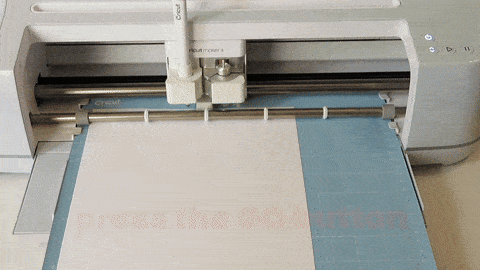
After the operations in clamp A are complete (scoring and drawing) the machine automatically performs the cut without pausing or requiring action from the user.
Final thoughts
Thanks for sticking with me through this journey through the very basics of Design Space. I hope you are feeling more confident in starting new projects and exploring some of the many cool features available to Cricut users!
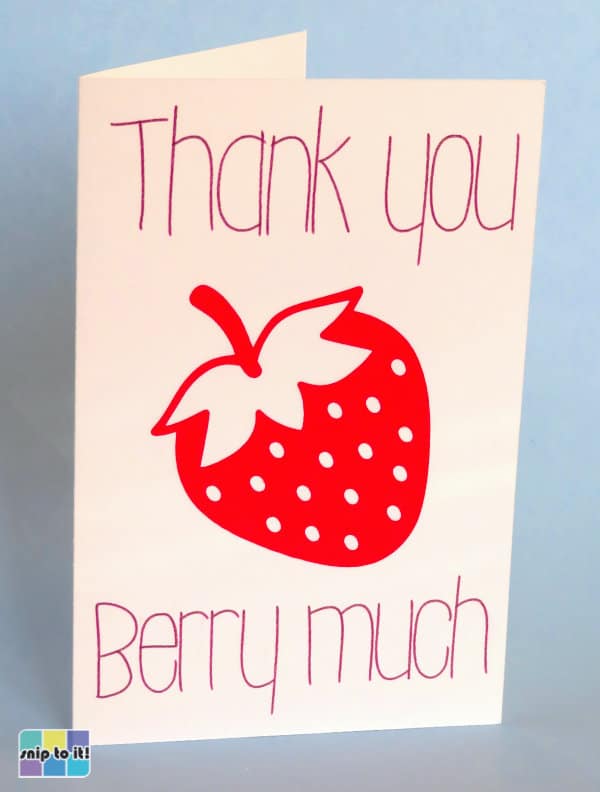
Keep browsing through my other Design Space tutorials and feel free to bookmark and re-read this article. I have tried to include as many relevant links as possible that will be a natural progression for your learning experience!
And remember: be kind to yourself when you’re crafting with your Cricut machine. It takes practice to learn this software, plus the ins and outs of the machine and how to use different types of material. Mistakes will be made. Projects will be less than perfect. But there is beauty in imperfection and each mistake is an opportunity for learning and improvement. I know you can do this! And I’ll be here to help you as much as I can.

